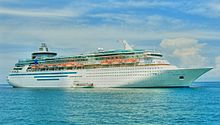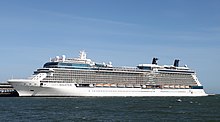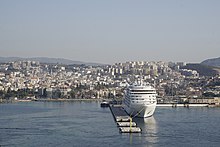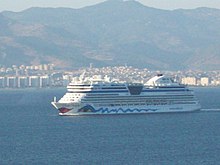Cruise ships are large passenger ships used mainly for vacationing. Unlike ocean liners, which are used for transport, they typically embark on round-trip voyages to various ports-of-call, where passengers may go on tours known as “shore excursions”. On “cruises to nowhere” or “nowhere voyages”, cruise ships make two- to three-night round trips without visiting any ports of call.

MS Galaxy at the port of Mariehamn, Åland, in February 2016.
Modern cruise ships tend to have less hull strength, speed, and agility compared to ocean liners. However, they have added amenities to cater to water tourists, with recent vessels being described as “balcony-laden floating condominiums”.
Cruise ships in Tallinn Passenger Port at Tallinn, Estonia – a popular tourist-destination
As of December 2018, there were 314 cruise ships operating worldwide, with a combined capacity of 537,000 passengers. Cruising has become a major part of the tourism industry, with an estimated market of $29.4 billion per year, and over 19 million passengers carried worldwide annually as of 2011. The industry’s rapid growth saw nine or more newly built ships catering to a North American clientele added every year since 2001, as well as others servicing European clientele until the Covid-19 pandemic in 2020 saw the entire industry all but shutdown.
As of 2021, the world’s largest passenger ship is Royal Caribbean’s Symphony of the Seas.
History
Origins

RMS Strathaird, a P&O cruise ship of the early-20th century. The company began offering luxury cruise services in 1844.
Italy, a traditional focus of the Grand Tour, offered an early cruise experience on the Francesco I, flying the flag of the Kingdom of the Two Sicilies. Built in 1831, the Francesco I sailed from Naples in early June 1833, preceded by an advertising campaign. Nobles, authorities, and royal princes from all over Europe boarded the cruise ship, which sailed in just over three months to Taormina, Catania, Syracuse, Malta, Corfu, Patras, Delphi, Zante, Athens, Smyrna and Constantinople, delighting passengers with excursions and guided tours, dancing, card tables on the deck and parties on board. However, it was restricted to the aristocracy of Europe and was not a commercial endeavour.
P&O first introduced passenger-cruising services in 1844, advertising sea tours to destinations such as Gibraltar, Malta and Athens, sailing from Southampton. The forerunner of modern cruise holidays, these voyages were the first of their kind. P&O Cruises is the world’s oldest cruise line. The company later introduced round trips to destinations such as Alexandria and Constantinople. It underwent a period of rapid expansion in the latter half of the 19th century, commissioning larger and more luxurious ships to serve the steadily expanding market. Notable ships of the era include the SS Ravenna built in 1880, which became the first ship built with a total steel superstructure, and the SS Valetta built in 1889, which was the first ship to use electric lights.

Prinzessin Victoria Luise was the first purpose-built cruise ship.
The cruise of the German ship Augusta Victoria in the Mediterranean and the Near East from 22 January to 22 March 1891, with 241 passengers (including Albert Ballin and his wife), popularized cruises to a wider market. Christian Wilhelm Allers published an illustrated account of it as Backschisch (Baksheesh).
The first vessel built exclusively for luxury cruising was Prinzessin Victoria Luise of Germany, designed by Albert Ballin, general manager of the Hamburg-America Line. The ship was completed in 1900.
The practice of luxury cruising made steady inroads into the more established market for transatlantic crossings. In the competition for passengers, ocean liners – Titanic being the most famous example – added luxuries such as fine dining, luxury services, and staterooms with finer appointments. In the late-19th century, Albert Ballin, director of the Hamburg-America Line, was the first to send his transatlantic ships out on long southern cruises during the worst of the North Atlantic winter seasons. Other companies followed suit. Some of them built specialized ships designed for easy transformation between summer crossings and winter cruising.
In 1897 three luxury liners, all European-owned, offered transportation between Europe and North America. In 1906 the number had increased to seven. The British Inman Line owned City of Paris, the Cunard Line had Campania and Lucania. The White Star Line owned Majestic and Teutonic. La Lorraine and La Savoie sailed for the French Compagnie Générale Transatlantique.
From luxury ocean liners to “megaship” cruising
With the advent of large passenger jet aircraft in the 1960s, intercontinental travelers switched from ships to planes sending the ocean liner trade into a terminal decline. Certain characteristics of older ocean liners made them unsuitable for cruising duties, such as high fuel consumption, deep draught preventing them from entering shallow ports, and cabins (often windowless) designed to maximize passenger numbers rather than comfort.

Queen Elizabeth 2 was reinvented as a luxury ocean liner following the advent of the jet airliner.
Ocean liner services aimed at passengers ceased in 1986, with the notable exception of transatlantic crossings operated by the British shipping company Cunard Line, catering to a niche market of those who appreciated the several days at sea. In an attempt to shift the focus of the market from passenger travel to cruising with entertainment value, Cunard Line pioneered the luxury cruise transatlantic service on board the Queen Elizabeth 2 ocean liner. International celebrities were hired to perform cabaret acts onboard and the crossing was advertised as a vacation in itself.
Queen Elizabeth 2 also inaugurated “one-class cruising” where all passengers received the same quality berthing and facilities. This revitalized the market as the appeal of luxury cruising began to catch on, on both sides of the Atlantic. The 1970s television series Love Boat helped to popularize the concept as a romantic opportunity for couples. Another ship to make this transition was SS Norway, originally the ocean liner SS France and later converted to cruising duties as the Caribbean’s first “super-ship”.

Sovereign of the Seas was the first “megaship” (in service 1988)
Contemporary cruise ships built in the late 1980s and later, such as Sovereign-class which broke the size record held for decades by Norway, showed characteristics of size and strength once reserved for ocean liners – some have undertaken regular scheduled transatlantic crossings. The Sovereign-class ships were the first “megaships” to be built for the mass cruising market, they also were the first series of cruise ships to include a multi-story atrium with glass elevators. They also had a single deck devoted entirely to cabins with private balconies instead of oceanview cabins. Other cruise lines soon launched ships with similar attributes, such as the Fantasy-class, leading up to the Panamax-type Vista-class, designed such that two-thirds of the oceanview staterooms have verandas. As the veranda suites were particularly lucrative for cruise lines, something which was lacking in older ocean liners, recent cruise ships have been designed to maximize such amenities and have been described as “balcony-laden floating condominiums”.

Oasis of the Seas (in service 2009)
Until 1975–1980, cruises offered shuffleboard, deck chairs, “drinks with umbrellas and little else for a few hundred passengers”. After 1980, they offered increasing amenities. As of 2010, city-sized ships have dozens of amenities.
There have been nine or more new cruise ships added every year since 2001, including the 11 members of the Vista-class, and all at 100,000 GT or greater. The only comparable ocean liner to be completed in recent years has been Cunard Line’s Queen Mary 2 in 2004. Following the retirement of her running mate Queen Elizabeth 2 in November 2008, Queen Mary 2 is the only liner operating on transatlantic routes, though she also sees significant service on cruise routes.

Oasis of the Seas with a 6-deck high outdoor area
Queen Mary 2 was for a time the largest passenger ship before being surpassed by Royal Caribbean International’s Freedom-class vessels in 2006. The Freedom-class ships were in turn overtaken by RCI’s own Oasis-class vessels which entered service in 2009 and 2010. A distinctive feature of Oasis-class ships is the split “open-atrium” structure, made possible by the hull’s extraordinary width, with the 6-deck high “Central Park” and “Boardwalk” outdoor areas running down the middle of the ship and verandas on all decks.
In two short decades (1988–2009), the largest class cruise ships have grown a third longer (268 m to 360 m), almost doubled their widths (32.2 m to 60.5 m), doubled the total passengers (2,744 to 5,400), and tripled in volume (73,000 GT to 225,000 GT). Also, the “megaships” went from a single deck with verandas to all decks with verandas.
Cruise lines

Celebrity Solstice in Port Melbourne, Australia
Operators of cruise ships are known as cruise lines, which are companies that sell cruises to the public. Cruise lines have a dual character; they are partly in the transportation business, and partly in the leisure entertainment business, a duality that carries down into the ships themselves, which have both a crew headed by the ship’s captain, and a hospitality staff headed by the equivalent of a hotel manager. Among cruise lines, some are direct descendants of the traditional passenger shipping lines (such as Cunard), while others were founded from the 1960s specifically for cruising.
Historically, the cruise ship business has been volatile. The ships are large capital investments with high operating costs. A persistent decrease in bookings can put a company in financial jeopardy. Cruise lines have sold, renovated, or renamed their ships to keep up with travel trends. Cruise lines operate their ships almost constantly. If the maintenance is unscheduled, it can result, potentially, in thousands of dissatisfied customers.
A wave of failures and consolidations in the 1990s led to many cruise lines being bought by much larger holding companies and continue to operate as “brands” or subsidiaries of the holding company. Brands continue to be maintained partly because of the expectation of repeat customer loyalty, and also to offer different levels of quality and service. For instance, Carnival Corporation & plc owns both Carnival Cruise Line, whose former image were vessels that had a reputation as “party ships” for younger travelers, but have become large, modern, yet still profitable, and Holland America Line, whose ships cultivate an image of classic elegance. In 2004, Carnival had merged Cunard’s headquarters with that of Princess Cruises in Santa Clarita, California so that administrative, financial and technology services could be combined, ending Cunard’s history where it had operated as a standalone company (subsidiary) regardless of parent ownership. However, Cunard did regain some independence in 2009 when its headquarters were moved to Carnival House in Southampton.

Silver Spirit in Kuşadası, Turkey
The common practice in the cruise industry in listing cruise ship transfers and orders is to list the smaller operating company, not the larger holding corporation, as the recipient cruise line of the sale, transfer, or new order. In other words, Carnival Cruise Line and Holland America Line, for example, are the cruise lines from this common industry practice point of view; whereas Carnival Corporation & plc and Royal Caribbean Cruises Ltd., for example, can be considered holding corporations of cruise lines. This industry practice of using the smaller operating company, not the larger holding corporation, is also followed in the list of cruise lines and in member-based reviews of cruise lines.
Some cruise lines have specialties; for example, Saga Cruises only allows passengers over 50 years old aboard their ships, and Star Clippers and formerly Windjammer Barefoot Cruises and Windstar Cruises only operate tall ships. Regent Seven Seas Cruises operates medium-sized vessels—smaller than the “megaships” of Carnival and Royal Caribbean—designed such that virtually all of their suites are balconies. Several specialty lines offer “expedition cruising” or only operate small ships, visiting certain destinations such as the Arctic and Antarctica, or the Galápagos Islands. John W. Brown, which formerly operated as part of the United States Merchant Marine during World War II before being converted to a museum ship, still gets underway several times a year for six-hour “Living History Cruises” that take the ship through Baltimore Harbor, down the Patapsco River, and into the Chesapeake Bay, and she is also the largest cruise ship operating under the American flag on the United States East Coast.
Currently the three largest cruise line holding companies and operators in the world are Carnival Corporation & plc, Royal Caribbean Cruises Ltd. and Norwegian Cruise Line Holdings.
As an industry, the total number of cabins on all of the world’s cruise ships amount to less than 2% of the world’s hotel rooms.
Organization
Disney Magic
AIDAdiva in İzmir
Cruise ships are organized much like floating hotels, with a complete hospitality staff in addition to the usual ship’s crew. It is not uncommon for the most luxurious ships to have more crew and staff than passengers.
Dining
Island Princess in Cabo San Lucas

Serenade of the Seas docking at the Port of Ponce, Puerto Rico at dawn
Dining on almost all cruise ships is included in the cruise price.
Traditionally, the ships’ restaurants organize two dinner services per day, early dining and late dining, and passengers are allocated a set dining time for the entire cruise; a recent trend is to allow diners to dine whenever they want. Having two dinner times allows the ship to have enough time and space to accommodate all of their guests. Having two different dinner services can cause some conflicts with some of the ship’s events (such as shows and performances) for the late diners, but this problem is usually fixed by having a shorter version of the event take place before late dinner. Cunard Line ships maintain the class tradition of ocean liners and have separate dining rooms for different types of suites, while Celebrity Cruises and Princess Cruises have a standard dining room and “upgrade” specialty restaurants that require pre-booking and cover charges. Many cruises schedule one or more “formal dining” nights. Guests dress “formally”, however that is defined for the ship, often suits and ties or even tuxedos for men, and formal dresses for women. The menu is more upscale than usual.
Besides the dining room, modern cruise ships often contain one or more casual buffet-style eateries, which may be open 24 hours and with menus that vary throughout the day to provide meals ranging from breakfast to late-night snacks. In recent years, cruise lines have started to include a diverse range of ethnically themed restaurants aboard each ship. Ships also feature numerous bars and nightclubs for passenger entertainment; the majority of cruise lines do not include alcoholic beverages in their fares and passengers are expected to pay for drinks as they consume them. Most cruise lines also prohibit passengers from bringing aboard and consuming their own beverages, including alcohol, while aboard. Alcohol purchased duty-free is sealed and returned to passengers when they disembark.
There is often a central galley responsible for serving all major restaurants aboard the ship, though specialty restaurants may have their own separate galleys.
As with any vessel, adequate provisioning is crucial, especially on a cruise ship serving several thousand meals at each seating. For example, a quasi “military operation” is required to load and unload 3600 passengers and eight tons of food at the beginning and end of each cruise, for the Royal Princess.
Other on-board facilities
Cruise ships require electrical power, normally provided by diesel generators, although an increasing number of new ships are fueled by Liquified Natural Gas (LNG). When docked, ships must run their generators continuously to power on-board facilities, unless they are capable of using onshore power, where available. Polluting emissions from the diesel engines can be equivalent to 700 trucks running their engines, and is harmful where ships dock in populated areas. Some cruise ships already support the use of shorepower, while others are being adapted to do so.
Modern cruise ships typically have aboard some or all of the following facilities:
-
- Casino — Only open when the ship is at sea to avoid conflict with local laws
- Shops — Only open when the ship is at sea to avoid merchandising licensing and local taxes
- Spa
- Fitness center
- Library
- Theatre with Broadway-style shows
- Cinema




